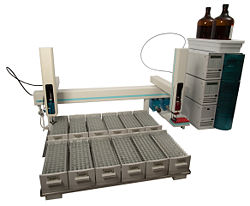Purification Applications
From LEAP

| Purification Applications |
| Application Type | |
| STANDARD AND SPECIAL | |
| Application ID | |
| Description | |
| Purification Applications |
General Description
The purpose of preparative-scale liquid chromatography is the isolation of materials conforming to a specified purity in the amounts that depend on the intended use of the product. Possible uses include the isolation of materials for structural elucidation, for biological or sensory evaluation (Eg:DMPKA), for organic synthesis or commercial applications. The scale of the operation includes laboratory, pilot plant and process-scale system. Process-scale separations will not be treated specifically in this section, since they represent a specialized area of chemical manufacturing and economic forecasting that the analytical chemist is infrequently exposed to.
From its inception liquid chromatography has been used as a preparative technique. Most chemist are familiar with the gravity feed glass column systems containing coarse adsorbent packings that are the main stay of laboratory practice. These low cost and easy to prepare and operate columns have many virtues. Not among them, however, are high resolution, short separation times and easy automation. When any of these factors are considered crucial then more sophisticated systems are required based on smaller particle sorbents with a narrow particle size distribution, that in turn are operated at above atmospheric pressure in the optimum mobile phase velocity range. These goals are best achieved using medium pressure and high pressure liquid chromatography.
Instead of gravity, a slight gas overpressure can be used to increase th sample throughput. This method is often called flash chromatography. Flash chromatography, also known as medium pressure chromatography, was popularized several years ago by Clark Still of Columbia University, as an alternative to slow and often inefficient gravity-fed chromatography. Flash chromatography provide a rapid (“over in a flash”)inexpensive general method for the preparative-scale separation of mixtures requiring only moderate resolution in amounts of 0.01 to 10 g depending on the difficulty of the separation and the column diameter (typically, 1-5cm).
When selecting the appropriate preparative-scale liquid chromatographic method for conditions requiring higher resolution or shorter processing times it is necessary to consider the intended use of the purified material. For example, 1-10 mg of a pure sample suffice for spectrocopic identification, while 1-10 g might be the minimum amount of an intermediate useful for an organice synthesis. The amount of sample required dictates the size of the column and the operating conditions necessary for the separation. The simplest approach to increasing the amount of sample recovered is to scale up an analytical separation using the same column packing, column length and linear mobile phase velocity while increasing the column diameter. The analytical separation should be optimized to maximize the separation factor between critical peak pairs at the expense of a longer separation time to permit the use of higher column loadings before the bands overlap. If the sample loading does not exceed the linear region of the sorption isotherm the results obtained are easily extrapolated from the analytical separation. Whith most analytical instruments the largest column size that can be used is about 25 cm long and 2.5cm internal diameter containing approximately 65 g of silica-based packing and requiring an optimun flow rate of 10-15 ml/min. For larger columns special purpose preparative scale instruments are usually neede to provide adequate flow and pressure capacity. Also, for the isolation of the maximum amount of sample a different approach to analytical separations is required. Success will be judged by the production rate and recovery yield obtained. The production rate is the amount of the purified fraction containing the corresponding component et the required degree of purity per unit of time. The recovery yield is the ratio between the amount of the component of interest that is collected in the product fraction and the amount injected in the column with the feed. the object is to maximize the production rate and the recovery yield, which invariably results in operating the column in a overloaded condition, such that the conditions predicted from an analytical separation have no direct meaning in establishing the optimum conditions for the separation. In fact, column operation under nonlinear or non-ideal conditions is very complex and it is not as easy to predict optimum operating conditions in this case as it is for the less demanding, although less powerful. scale-up approach to preparative liquid chromatography. several general reviews of high pressure preparative-scale liquid chromatography are available as well as application reviews for specific compound classes.
Significant Markets
- Pharmaceutical - Drug Discovery,
